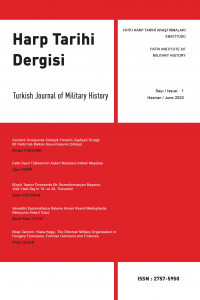Osmanlı Devleti’nde Askerî Amaçlı Kullanılan Helyostalar
Military communication means providing information transfer from discovery and contact units. Firstly, military communication was made by using runners. However, visual and auditory signals were used because of the heavy consequences of its inadequacy in the armed forces. After some time, heliostat was made because of the importance of military communication and the great needs. Heliostat consists of a mirror and an adjustment system used to direct the reflected sun rays to a certain point and keep them in this direction. The importance of the heliostat was noticed with the military innovations in the Ottoman State. Negotiations were made with companies in Europe to buy heliostats. Great convenience was provided in military communication and information transfer by using heliostats. In this study, the characteristics of heliostats, their purchase from Europe and the process of using them are explained by using the Ottoman Archives, instructions and ancient artifacts.
Anahtar Kelimeler:
Heliostat, Askeri, İletişim, Osmanlı Devleti
The Heliostats Used For Military Purposes in the Ottoman State
Military communication means providing information transfer from discovery and contact units. Firstly, military communication was made by using runners. However, visual and auditory signals were used because of the heavy consequences of its inadequacy in the armed forces. After some time, heliostat was made because of the importance of military communication and the great needs. Heliostat consists of a mirror and an adjustment system used to direct the reflected sun rays to a certain point and keep them in this direction. The importance of the heliostat was noticed with the military innovations in the Ottoman State. Negotiations were made with companies in Europe to buy heliostats. Great convenience was provided in military communication and information transfer by using heliostats. In this study, the characteristics of heliostats, their purchase from Europe and the process of using them are explained by using the Ottoman Archives, instructions and ancient artifacts.
Keywords:
Heliostat, Military, Communication, Ottoman Empire,
___
- BOA, Bâbıâlî Evrak Odası (BEO), 3698/277294, 24 Muharrem 1328 [5 Şubat 1910]
- BOA, Dâhiliye Nezâreti Şifre (DH.ŞFR), 393/86, 9 Zilhicce 1323 [4 Şubat 1906], 611/108, 24 Muharrem 1335 [20 Kasım 1916]
- BOA, Dâhiliye Nezâreti İdare (DH.İD), 145/6-1, 3 Zilkâde 1330 [14 Ekim 1912], 145/6-2, 3 Zilkâde 1330 [14 Ekim 1912]
- BOA, Hâriciye Nezâreti Sefâreti (HR.SFR.3), 306/1, 10 Şubat 1885, 299/72, 19 Kasım 1884
- BOA, İrâde Bahriye (İ.BH), 7/32-3, 6 Safer 1328 [17 Şubat 1910], 7/32-1, 21 Muharrem 1328 [2 Şubat 1910]. 7/32-2, 17 Muharrem 1328 [29 Ocak 1910]
- BOA, Yıldız Perâkende Elçilik, Şehbenderlik, Ataşemiliterlik (Y.PRK.EŞA), 45/15-1, 29 Zilkâde 1321 [16 Şubat 1904], 45/15-2, 29 Zilkâde 1321 [16 Şubat 1904]
- BOA, Yıldız Mütenevvi Marûzat Evrâkı (Y.MTV), 255/61, 7 Zilkâde 1321 [25 Ocak 1904]. 306/158, 23 Muharrem 1326 [26 Şubat 1908]. 306/158-2, 23 Muharrem 1326 [26 Şubat 1908]
- “Askerî Bölüğün Helyosta ile Muhabere-i Rasadiyye Ta’lîmi, Şehbâl, İstanbul 1914
- H. STERLING, Christopher, Military Ancient Times to the 21st Century, California 2008
- MARCON, Fanny, Physics İnstrument Makers in 19th- Century Veneto: Two Case-studies, SIF Congress, Italy 2020, s. 1-5
- Helyosta Ta’lîmâtnâmesi, Matbaa-i Askeriye, İstanbul 1325 (1907)
- COTTINGHAM, John, Solar-Powered Steam Generator Heliostat, United States Department of Energy, Newyork 1978
- Mehmed Vasıf, Mesâha-i Bahriye, Kasbar Matbaası, Dersaadet 1322 (1904)
- Mehmed Şakir bin Feyzullah, Piyade Tayyareleri ve Piyade Balonları, Matbaa-i Askeriye, İstanbul 1335 (1916)
- On Beş Santimetrelik Piyade ve Süvari Helyostatı, Matbaa-i Askeriye, İstanbul 1328 (1910)
- The United Service, A Monthly Review of Military and Naval Affairs, Philadelphia 1880
- KNOWLES MIDDLETON, William Edgar, Giovanni Alfonso Borelli and the Invention of the Heliostat, Vancouver 2020
- ISSN: 2757-5950
- Başlangıç: 2020
- Yayıncı: Millî Savunma Üniversitesi
Sayıdaki Diğer Makaleler
H.1327/M.1911 Piyade Techizatı Adlı Eserin Transkripsiyonu
1768-1774 Osmanlı-Rus Savaşı Hakkında Çağdaş Bir Kaynak
Urban Topu’nun Balistik Özelliklerinin 15. Yüzyıldaki Çağdaşlarıyla Karşılaştırılması
Büyük Taarruz Başlangıcında Batı Cephesi Birlik ve Komutanlarının Tespitine Dair Bir Analiz
